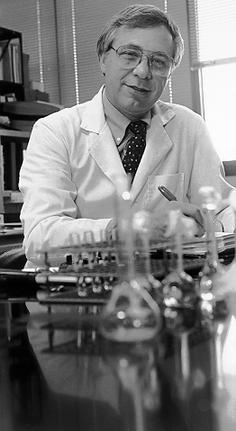VUMC investigator lauded for diabetes research

Alan Cherrington, Ph.D.
For the third time, a Vanderbilt University Medical Center researcher has won the coveted Fredrick Banting Award, given yearly by the American Diabetes Association for outstanding achievement in the area of diabetes/metabolism research.
Alan D. Cherrington, Ph.D., professor of Molecular Physiology and Biophysics, recently won the award for his work defining the way hormones regulate energy metabolism and how the body responds to the ingestion of various nutrients.
The honor places Cherrington in lofty company. Previous award winners from VUMC include Nobel Laureate, Dr. Earl Sutherland Jr., for his work on Cyclic AMP, and Dr. Charles R. Park, emeritus professor of Physiology, emeritus, for his work on insulin action on glucose transport.
"This is an award for a body of work, rather then for one particular finding or one given individual," said Cherrington. "For me this is a recognition of the efforts of many people, so it is fun to accept this not only on my own behalf but on behalf of the students, fellows, and colleagues who I worked with in carrying out this work."
Cherrington's research focuses on diabetes, but could also lead to new understandings of how nutrition can impact on recovery following injury or patients with weight disorders like obesity.
Cherrington's research defining the mechanisms by which hormones regulate energy metabolism.
In order to isolate a single signal, Cherrington used animal models to break the feedback loops of the hormones which would normally protect the animal.
For example, if a researcher were to give an animal a dose of glucagon, the blood sugar would go up. Immediately after that, however, the body would mount a defense and within minutes the effect would be completely invisible.
"It is our ability to unmask the effects of different agents through surgical and pharmacological techniques that has allowed us to understand the role of hormones in the mechanism of energy metabolism," said Cherrington.
Cherrington initially focused on glucagon which is secreted from the pancreas.
"Our work has helped establish glucagon as being a critical partner with insulin in regulating the level of blood glucose," said Cherrington. "We now know that glucagon is the primary way that your body stimulates the liver to add sugar to your blood. In that regard it opposes insulin action, which inhibits glucose production."
Cherrington studied the way in which glucagon effects the liver, how sensitive that effect is, what metabolic processes glucagon affects and the speed with which glucagon can turn the liver on.
After defining the basic mechanisms by which glucagon works in the body, Cherrington's lab moved on to study epinephrine, which comes from the adrenal gland, and norepinephrine, which is secreted by the nerve terminals.
While these hormones do not function as minute-to-minute regulators of basal metabolism, they represent a backup or emergency system during times of stress.
"We were able to show that at baseline levels, when you are not stressed, there are not enough of these hormones to accomplish anything. But the minute you become stressed, their blood levels go up and they begin to have certain actions in the liver, muscle, and fat to make sure that the body is at an optimal energy state," said Cherrington.
Cherrington's lab is now beginning to study the largely unknown role of the nervous system in regulating energy metabolism.
Recently, Cherrington has studied the manner in which the body responds to nutrient intake.
Previously it was believed that when glucose was ingested blood sugar rose. The beta cell in the pancreas sees the blood sugar rising and secretes insulin. Glucose and insulin then signal the tissues in the body to store the appropriate amounts of sugar.
"In the late 70's a study was published that indicated that you could take human beings and infuse glucose and insulin through an arm vein and no matter how high you put the glucose and insulin the liver would not store glucose," said Cherrington.
This was the impetus for Cherrington's subsequent research.
He said the body has a unique way of knowing when a person is eating. When you ingest glucose, it is first taken into the digestive tract and then is absorbed into the bloodstream. The first place that the glucose travels to is the portal vein, which carries blood from the gut to the liver.
"There are glucose monitoring cells in the portal vein that are constantly reading the level of glucose, like a thermostat in your house. There is also a similar thermostat, which we think is in the brain, that compares the two readings. In non-feeding conditions the two values would be the same," said Cherrington.
When we ingest sugar, however, the glucose in the portal vein rises and this produces a signal which tells the body to start distributing the glucose to the various tissues of the body in a specific way.
The brain then creates three responses: it turns on the liver and makes it better able to consume glucose; it turns off the muscles and inhibits their ability to take up glucose; and it sends a message to the pancreas to enhance insulin secretion.
"The concept that a nutrient like glucose can act not only as a carbon source but also as a signal is very important and is now being extended to other nutrients, such as free fatty acids and amino acids. A better understanding the interaction between nutrients, hormones, and the nervous system in controlling response to feeding should improve our ability to treat patients with disease and injury," said Cherrington.













